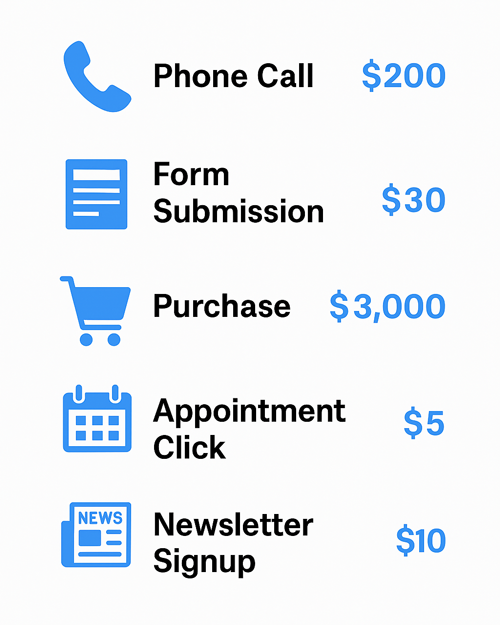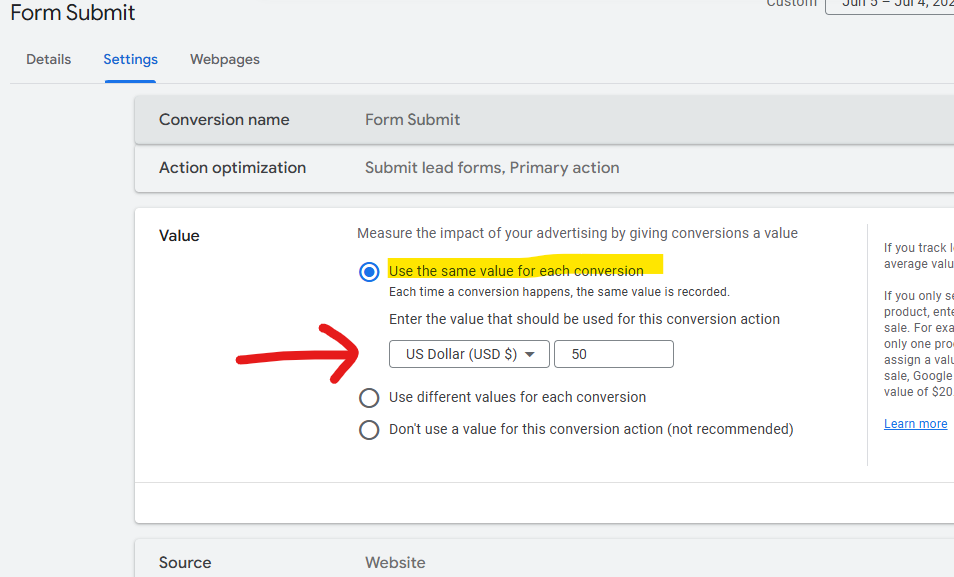If you’re already tracking conversions in your Google Ads campaigns, you’re on the right track. But many advertisers are missing out on a powerful optimization tool: conversion values.
In this post, we’ll break down what conversion values are, when you should use them, and how they can significantly improve your bidding strategy and ROI.
What Are Conversion Values?
Conversion values are numerical values assigned to different types of conversions—like phone calls, form submissions, or purchases—based on how valuable they are to your business. These values help Google Ads understand which actions are most important, so it can optimize your campaigns accordingly.
For example:
- A phone call might be worth $200 to a medical facility.
- A form submission might be worth only $30.
- A click to schedule an appointment might be worth $5, because it’s not a confirmed appointment yet.

If you don’t assign values, Google Ads treats all conversions equally—which may lead to wasted budget if some conversion types are much less valuable than others.
Why Conversion Values Matter
Not all conversions are created equal. A simple newsletter signup is not as valuable as an actual purchase. Assigning values helps you:
- Prioritize higher-value conversions.
- Use smarter bidding strategies, especially “Maximize Conversion Value.”
- Understand ROI more clearly across campaigns.
Here’s what it looks like inside Google Ads:
- Navigate to Goals > View All Conversion Actions.
- Click on a specific conversion (like a phone call or form submission).
- Set a value: choose the same value for all conversions, or different values depending on the conversion type.

Real-World Examples Of Conversion Values
1. Medical Client (Lead Generation)
One of my medical clients tracks three main types of conversions:
- Phone Calls: Valued at $200
- Form Submissions: Valued at $30
- Appointment Clicks: Valued at $5 (not an appointment, but just a click on the appointment link which directs to a different site)
By assigning different values, the campaign avoids over-prioritizing low-value actions like appointment clicks, which are frequent but less meaningful.
2. E-Commerce + Lead Gen Hybrid
Another client runs both e-commerce and lead generation:
- Product Purchases: Values tracked dynamically based on sale price.
- Sample Orders: Valued at $100 (not profitable but sample orders are good leads).
- Newsletter Signups: Valued at $10
- Phone Calls & Form Submissions: Valued at $100
Imagine treating a $3,000 purchase the same as a newsletter signup—clearly not ideal! Conversion values let us make that distinction and optimize accordingly.
Leveraging Smart Bidding: Maximize Conversion Value
Once your conversion values are set, you can use the Maximize Conversion Value bidding strategy. This tells Google Ads to focus on getting the highest possible value for your budget—not just the most conversions.
You can also set a Target ROAS (Return on Ad Spend). For example, if you want $2 in revenue for every $1 spent, you’d set a 200% target.
When Should You Use Conversion Values?
Use conversion values if:
- You have multiple conversion types with varying importance.
- You’re running e-commerce or tracking lead quality.
- You want to switch from “Maximize Conversions” to “Maximize Conversion Value.”
Even if you assign rough estimates to start, having relative values is often more important than the exact number.
Final Thoughts
Assigning conversion values adds a layer of intelligence to your campaigns. It helps Google’s algorithms make better decisions and ensures you’re not spending budget on low-value actions.
Setting them up might take a bit of initial effort, but the insights and performance improvements are well worth it.
